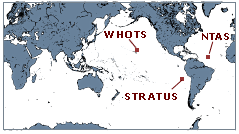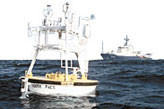Reference Data Sets

The Upper Ocean Processes Group (UOP) specializes in the collection of long-term, climate quality time series of surface meteorology and of air-sea fluxes of heat, freshwater, and momentum from open-ocean moorings, known as Ocean Reference Stations (ORS). Our ORS are deployed under the stratus cloud deck in the eastern tropical Pacific (Stratus), in the trade wind region of the northwest tropical Atlantic (NTAS), and 100 km north of Oahu at the WHOI Hawaii Ocean Time-series Site (WHOTS).
In addition to surface meteorological observations, UOP has deployed deep ocean temperature sensors as part of the OceanSITES Deep Ocean Temperature initiative. Quality-controlled time series from these deep sea measurements are available in the Deep Sea Temperature reference dataset.
Typically, the surface moorings are serviced annually, with the new mooring overlapping the old one for one to several days. The data from each deployment, including real time data from current deployments, are available under the Current Projects button, to the left.
The time series records from each deployment have been merged to make as long as possible continuous time series. Shipboard observations, the comparison of the old and new time series, and laboratory calibrations are used to correct drifts and select the best time series from each deployment to be merged into these long time series files. In the case of a mooring failure and a long time gap, we have not made an attempt to bridge the gap, and the site then has more than one file.
The buoys are not reset in exactly the same location, but the time series have been merged and presented as from one site. These merged Reference Data Sets and supporting documentation are made available at hourly, daily, and monthly time resolution under the Reference Data Sets sites listed in the left-hand navigation buttons.
The surface meteorological data at the ORS are available via satellite telemetry, but are not placed on the GTS and are not used in atmospheric model initialization. Thus, these are independent, withheld data of use for model validation. At the same time, the processes of calibrating the meteorological sensors and quality controlling the data are rigorous and well-documented.
Deployment Summary
A summary of the deployments at the three ORS sites is available
at deploymentSummary.html.
Last updated: July 11, 2019

